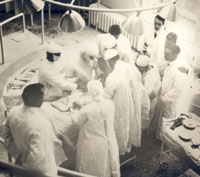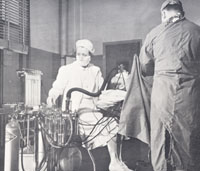Health Professions
A Brief Note on Nurse Anesthetists
Anesthesiology in the first quarter of the 20th century was not yet a recognized medical specialty. The medical students, interns, nurses, dentists, or referring physicians who were called upon to administer anesthesia brought with them varying degrees of training and experience. As a result, many surgeons hired their own personal anesthetists (often specially trained nurses) to assist them. Many surgeons felt nurses were best suited to anesthesiology, since they were focused on the needs of the patients during surgery. It was also more economical for the surgeon, because nurse anesthetists were paid as staff nurses by the hospitals, leaving surgical payments to go to the surgeon alone.
The first formal education program for nurse anesthetists was established at St. Vincent’s Hospital in Portland, Oregon in 1909. The curriculum included courses on anatomy and physiology, pharmacology, and administration of common anesthetic agents. By 1920 almost 20 hospitals offered four- to six-month graduate programs in nurse anesthesia. Graduates often included not only nurses but also dentists and physicians. At the time, there was only one post-graduate anesthesia training course just for physicians.
During the First World War nurses were the principal health care professionals to administer anesthesia to the wounded. After the war, nurse anesthetists continued as the primary providers of anesthesia, despite some legal battles brought by physicians challenging that the nurses were practicing medicine. Anesthesiology as a medical specialty slowly grew between the wars, though by 1942 there were still 17 nurse anesthetists for every one anesthesiologist.
Anesthesiology as a medical specialty began to attract more physicians in the 1950s and 1960s as surgical operations became more complex and specialized anesthetic methods were introduced (such as spinal, intravenous, and regional nerve block techniques). However, anesthesiology as a nursing specialty continues to thrive – there are about an equal number of anesthesiologists and CRNA’s (Certified Registered Nurse Anesthetists) in the United States today. CRNA’s administer about 65% of the anesthetics given to patients each year and are the sole providers of anesthesia services in about 85% of the America’s rural population.
Related Links:
Return to Nursing (Health Professions)
Return to Health Professions
Back to Top



